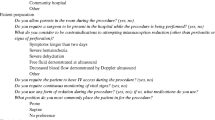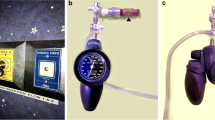Abstract
Background
Image-guided intussusception reduction has been practised internationally for many decades. The use of different modalities, delayed repeat attempts, and sedation/anaesthesia are unknown.
Objective
To survey the practice of image-guided intussusception reduction.
Materials and methods
A 20-point questionnaire created by the European Society of Paediatric Radiology (ESPR) Abdominal Imaging Taskforce was distributed via the ESPR members’ mailing list and shared on social media between 28 March and 1 May 2023.
Results
There were 69 responses from 65 worldwide institutions, with a mean of 18 intussusception reductions performed per year: 55/69 (80%) from 52 European institutions and 14/69 (20%) from 13 institutions outside of Europe. European centres reported using 19/52 (37%) fluoroscopy, 18/52 (35%) ultrasound, and 15/52 (28%) a mixture of both, with 30/52 (58%) offering a delayed repeat at 15 min to 24 h. Non-European centres reported using 5/13 (39%) fluoroscopy, 6/13 ultrasound (46%), and 2/13 (15%) a mixture of both, with 9/13 (69%) offering a delayed repeat attempt. Sedation or analgesia was used in 35/52 (67%) of European and 2/13 (15%) non-European institutions.
Conclusion
There is wide variation in how image-guided intussusception reduction is performed, and in the use of sedation/anaesthesia.











Similar content being viewed by others
Data Availability
Data available within the article.
References
Bekdash B, Merven S, Sprigg A (2013) Reduction of intussusception: defining a better index of successful non-operative treatment. Pediatr Radiol 43:649–656
Sadigh G, Zou K, Razavi S et al (2015) Meta-analysis of air versus liquid enema for intussusception reduction in children. AJR Am J Roentgenol 205:W542-549
Rosenfeld K, McHugh K (1999) Survey of intussusception reduction in England, Scotland and Wales: how and why we could do better. Clin Radiol 54:452–458
Fiegel H, Gfroerer S, Rolle U (2016) Systematic review shows that pathological lead points are important and frequent in intussusception and are not limited to infants. Acta Paediatr 105:1275–1279
Chew R, Ditchfield M, Paul E, Goergen S (2017) Comparison of safety and efficacy of image-guided enema reduction techniques for paediatric intussusception: a review of the literature. J Med Imaging Radiat Oncol 61:711–717
Plut D, Phillips G, Johnston P, Lee E (2020) Practical imaging strategies for intussusception in children. AJR Am J Roentgenol 215:1449–1463
Sanchez T, Doskocil B, Stein-Wexler R (2015) Nonsurgical management of childhood intussusception: retrospective comparison between sonographic and fluoroscopic guidance. J Ultrasound Med 34:59–63
Google Forms (2023) ESPR intussusception reduction survey. Available: https://forms.gle/ypmvgjPd64uuALrP7. Accessed 30 April 2023
Gu L, Alton D, Daneman A et al (1988) Intussusception reduction in children by rectal insufflation of air. AJR Am J Roentgenol 150:1345–1348
Yoon S, Han C, Eun S (2022) Impact of the COVID-19 pandemic on the incidence of intussusception: a systematic review. Eur Rev Med Pharmacol Sci 26:9040–9049
Xie X, Wu Y, Wang Q et al (2018) A randomized trial of pneumatic reduction versus hydrostatic reduction for intussusception in pediatric patients. J Pediatr Surg 53:1464–1468
Schmit P, Rohrschneider W, Christmann D (1999) Intestinal intussusception survey about diagnostic and nonsurgical therapeutic procedures. Pediatr Radiol 29:752–761
Stein-Wexler R, O’Connor R, Daldrup-Link H, Wootton-Gorges S (2015) Current methods for reducing intussusception: survey results. Pediatr Radiol 45:667–674
Nguyen H, Sammer M, Ditzler M et al (2021) Transition to ultrasound as the first-line imaging modality for midgut volvulus: keys to a successful roll-out. Pediatr Radiol 51:506–515
Riccabona M (2012) Application of a second-generation US contrast agent in infants and children-a European questionnaire-based survey. Pediatr Radiol 42:1471–1480
Ellison J, Maxfield C, Wiener J (2009) Voiding cystography practices and preferences of North American pediatric urologists. J Urol 182:299–304
Navarro O, Daneman A, Chae A (2004) Intussusception: the use of delayed, repeated reduction attempts and the management of intussusceptions due to pathologic lead points in pediatric patients. AJR Am J Roentgenol 182:1169–1176
van de Bunt J, Veldhoen E, Nievelstein R et al (2017) Effects of esketamine sedation compared to morphine analgesia on hydrostatic reduction of intussusception: a case-cohort comparison study. Paediatr Anaesth 27:1091–1097
Giacalone M, Pierantoni L, Selvi V et al (2022) Midazolam premedication in ileocolic intussusception: a retrospective multicenter study. Eur J Pediatr 181:3531–3536
Teoh K, Palmer G, Teague W et al (2021) Periprocedural analgesia and sedation in air enema reduction for intussusception: a retrospective Australian cohort study. J Paediatr Child Health 57:103–108
Feldman O, Weiser G, Hanna M et al (2017) Success rate of pneumatic reduction of intussusception with and without sedation. Paediatr Anaesth 27:190–195
Khorana J, Tepjuk S, Singhavejsakul J et al (2023) A comparison of the success rate of pneumatic reduction in intussusception between general anesthesia and deep sedation: a randomized controlled trial. Pediatr Surg Int 39:186
Author information
Authors and Affiliations
Contributions
G.P. conceptualised and designed the study. R.M., L-S.O-M., S.S., S.F.A., C.S., A.C., P.P., and G.P prepared material and collected data. R.M. and G.P. performed data analysis and wrote the first draft of the manuscript. All authors contributed to review and editing of the draft. All authors read and approved the final manuscript.
Corresponding author
Ethics declarations
Conflicts of interest
None
Additional information
Publisher's Note
Springer Nature remains neutral with regard to jurisdictional claims in published maps and institutional affiliations.
Rights and permissions
Springer Nature or its licensor (e.g. a society or other partner) holds exclusive rights to this article under a publishing agreement with the author(s) or other rightsholder(s); author self-archiving of the accepted manuscript version of this article is solely governed by the terms of such publishing agreement and applicable law.
About this article
Cite this article
Meshaka, R., Müller, LS.O., Stafrace, S. et al. Intussusception reduction methods in daily practice—a survey by the European Society of Paediatric Radiology Abdominal Imaging Taskforce. Pediatr Radiol 54, 571–584 (2024). https://doi.org/10.1007/s00247-023-05798-0
Received:
Revised:
Accepted:
Published:
Issue Date:
DOI: https://doi.org/10.1007/s00247-023-05798-0




